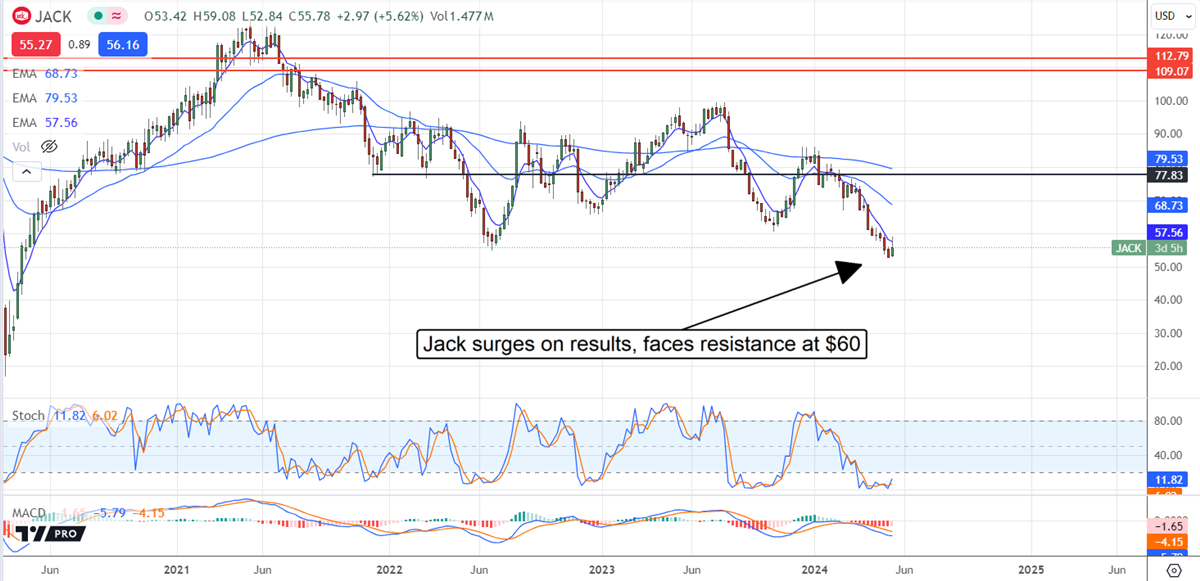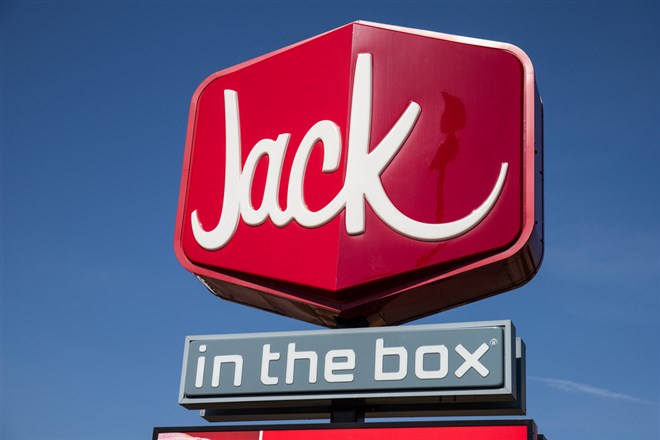Ticker Reports for May 14th
Jack in the Box Bottoms and the Rebound is on
Jack in the Box (NASDAQ: JACK) share prices tumbled over the last year as the Del Taco acquisition weighed on sentiment, but the rebound is on, and the upside looks tasty. The acquisition was questionable, and the rationalization of the business took longer to gain traction than expected, but it is gaining traction. The Q2 results aren’t stellar but reveal the impact of Del Taco's re-franchising efforts and point to a return to growth by fiscal year-end with accelerated bottom-line results.
How high can the rebound go? It can go quite high, using the analysts as a gauge. Trading near $53, JACK shares were at the lowest level since the pandemic bottom and offered up a deep value opportunity relative to their outlook. At $53, even at $57.50, the stock is below the analysts’ lowest target, with a potential for a 50% upside at the consensus midpoint.
Jack in the Box has Mixed Quarter: Positioning for Growth
Jack in the Box had a mixed quarter. The $365.35 million in revenue is down 7.7% from last year and missed the consensus target by 100 basis points. Still, the weakness is primarily due to re-franchising compounded by soft market conditions. The core Jack in the Box brand saw sales contract by 1.6% on a -2.5% contraction in comps offset by a slightly higher store count. The smaller Del Taco segment contracted 1.3% on a 1.4% decline in comps.
The strength is seen in the margin. Sales trends and re-franchising impacted the company’s margins, but lower SG&A helped offset this. The net result is a 6% decline in adjusted EBITDA compared to the 7.7% top-line decline and adjusted earnings that are roughly flat compared to last year.
The adjusted $1.46 is a penny shy of last year’s adjusted result and aided by share repurchases. Jack in the Box repurchased 0.2 million shares in Q2 to bring the average count down by 5% compared to last year. The company has $210 million left under the current authorization, so it is expected to continue repurchasing as the year progresses.
Jack in the Box Capital Returns Come With Risk
Jack in the Box has an attractive capital return with combined dividends and share repurchases of more than 8% in effective yield. The dividend is safe at face value with a payout ratio of less than 35%, but there are risks. The annualized outlook is solid, but Q2 results include negative cash flow and a sharp decrease in balance sheet cash that poses a threat. Cash flow should improve as the year progresses, with re-franchising leading to leaner operations and impairments falling off the books, but this detail should not be ignored.
Meanwhile, Jack in the Box is growing. The company increased the store count for both segments during Q2 and expects to continue growing the footprint this year. Del Taco is expanding in Greensboro, NC and Atlanta, GA, while Jack in the Box added five new development agreements in Florida. The agreements are for restaurant locations in Tallahassee and Orlando, bringing the total of signed but not completed projects to 365, a 15% increase in the footprint.
The Technical Outlook: Jack in the Box is at Rock Bottom
Jack in the Box shares fell to rock bottom pricing ahead of the Q2 release and confirmed support at a critical level following. The market is up nearly 10% in a high-conviction move and is likely to continue higher. There is potential for resistance at the $60 level, but oversold stochastic and MACD and divergence in the MACD histogram suggests the rebound will not stop there. if it does, this stock could fall below $50 soon. However, a move above $60 (the lowest analyst price target tracked by Marketbeat) opens the door to $70 and $77, which may be reached soon. If the company can continue gaining traction, it could continue rallying to retest the high end of its trading range by the end of the year.

Trump Exposes Sinister conspiracy to Fed-Controlled Digital Currency.
Donald Trump once again sounded the alarm against Fed-controlled digital currencies (CBDCs).
If these plans are implemented, it could mean the end of America as we know it.
On Shares Move Higher in Race to a New All-Time High
On’s (NYSE: ONON) Q1 results prove it is gaining traction with athletes and is on track to dethrone Nike (NYSE: NKE) as the god of running shoes. The company’s results exceeded expectations on strength in all channels, segments, and geographical regions and are expected to accelerate as the year progresses.
Evidence the shoes are more than a fad includes the latest Boston Marathon win. Helen Obiri of Kenya became the 6th woman to repeat back-to-back wins, the first since 2005, wearing a pair of On running shoes both times. The takeaway is that winners who care about comfort and quality are turning to On and On is expanding into new verticals, growing its addressable market.
On Has Robust, Record-Setting Quarter, Gives Cautious Guidance
On had a solid quarter with revenue of $640.36 million, exceeding the Marketbeat.com consensus by a significant margin. The top line exceeded consensus by 1650 basis points to set a new all-time record and provide leverage to the bottom line. Revenue is up 20.9% compared to last year, led by the DTC channel. DTC sales, the higher margin channel, grew by 39%as-reported, and 49% on an FXN basis and are now 37.5% of the mix. Wholesales grew by 12%. Segmentally, Accessories grew fastest at 36%, but the core shoe segment also grew robustly at 21%.
Margin news is good. The company widened its gross and operating margins on strength in DTC, sales leverage, and cost controls. Adjusted EBITDA increased by 27% on a 15.2% margin, up 70 bps YOY, to leave earnings at $0.36. This is more than double last year, suggesting that guidance is very cautious.
On raised its guidance, providing another catalyst for the market. The takeaway for investors is that guidance expects quarterly growth to accelerate above 30% by year-end and for the margin to expand. The $2.52 billion in revenue aligns with the consensus estimate but is likely cautious given the Q1 strength and brand momentum.
On’s Balance Sheet is a Fortress; Can Invest in Growth
On’s balance sheet is a fortress with no long-term debt and a growing cash position. The cash is up nearly 19% compared to last year, nearly $650 million, setting the company up to invest in growth and return capital to shareholders. The company does not currently pay dividends or repurchase shares but could begin doing so soon. Until then, investors might expect to see On’s growth continue robustly for years due to its lean into new verticals. Shoe lines targeting tennis and training are gaining traction and improving the total addressable market; competitor Nike stands to lose share.
Analysts favor On and will likely lead this market higher. The seventeen tracked by Marketbeat.com rate the stock at a consensus Moderate Buy, and they have been revising their price targets to be higher. The consensus going into the report is $37.50, up 25% compared to last year and 10% above the pre-release price action.
On Surges 20%: New Highs are in Sight
On’s stock price surged 20% at the open, exceeding the analysts' consensus target. The market shows a solid trend-following signal that should take it to a fresh high, but there is risk. Signs of resistance at the top of a trading range may cap gains near $37. A move above that level would be bullish; failing to do so would leave the market range bound at current levels. In the event new highs are reached and held, the market could advance another $10 with or without the aid of the analysts. If the analysts raise their targets, the upside potential increases.

Bitcoin's Biggest Year Yet
2024 is set to be a historic year for Bitcoin.
It's all thanks to three major catalysts that I reveal in my newest video.
What Wall Street Doesn't Want You to Know About Alibaba Stock
Shares of Alibaba Group (NYSE: BABA) fell by as much as 5% in the pre-market session of May 14th; the reaction came after a wild first quarter 2024 earnings result, which is arguably the most critical report of the year as it sets the tone for what may come in the following months. Without digging deeper into the company’s financials, any retail investor would be wrongly scared away.
After a massive decline in net income, the stock should have made new all-time lows, yet it remains within the tight range it has traded under for the past three years. This means some are out there providing enough buying pressure to keep the stock from plummeting. Today, investors will get an insight into why Wall Street isn’t telling the world the whole story.
Behind Alibaba’s negative earnings release lies a simple – yet powerful - fundamental fact that will have the opposite effect in the following quarters, particularly as the Chinese economy shows signs of a potential comeback shortly. Taken as a proxy, the iShares MSCI China ETF (NASDAQ: MCHI) outperformed the S&P 500 by more than 20% in the past quarter; investors could assume that momentum – and sentiment – has improved for Chinese stocks.
Turning One of The World’s Biggest Ships
China is the second-largest economy in the world and plays a crucial role in global markets. Specifically, Alibaba is one of the largest business-to-business (B2B) players in the technology sector, capturing nearly twice the global e-commerce market share that Amazon.com Inc. (NASDAQ: AMZN) did.
The Chinese government, noticing its stock market value decline to near decade-lows, decided to react and push future prospects back up. Among the many stimulus measures applied to the economy, the latest round came through a $138 billion bond sale.
Considering that there is enough demand for Chinese bonds for the government to consider selling them, investors can see the growing interest from international investors in entering China. However, don’t follow this thread until all the facts are in.
One of these facts is the green light from Ray Dalio, who—since the third quarter of 2023—has been buying into the China ETF. Michael Burry (yes, the guy who called the 2008 financial crisis) reports his largest positions in both Alibaba and JD.com Inc. (NASDAQ: JD), betting that China’s comeback will be led by consumer discretionary stocks first.
After posting mostly negative inflation data, China has achieved three consecutive months (a whole quarter) of positive inflation, which signals the potential return of consumer demand. More than that, the Caixin Composite PMI, a reading on overall business activity, has expanded since November 2023, increasing the odds of corporate profits ahead.
However, not all profits are made equal. Here’s why Alibaba’s net income decline is a trick to keep Main Street outside this valued gem.
An 86% Drop, But Not Really
That’s right, net income plummeted by 86% over the year, which should have been enough to send the stock in the opposite direction of GameStop Corp. (NYSE: GME), which rose in the opposite direction on what could be the revival of meme stocks.
However, following the potential Chinese economic recovery, Alibaba shows all the right signs. According to Alibaba’s press release, revenue increased by 4% in the company’s largest segment (Taobao & Tmall Group).
The most exciting business found in Alibaba’s cloud computing segment, which competes against Amazon’s AWS, also posted 3% revenue growth.
All others posted double-digit growth in the digital commerce and logistics networks business. As these mainly serve the Greater China region, results show investors that the Chinese economy could be on the right track to stage a comeback this year.
Here’s where investors can justify Citigroup’s $124 price target for Alibaba, calling for a 55% upside from where the stock fell recently. According to management and the company’s financials, the significant contraction in net income came from a net loss of roughly $1.4 billion in equity investments.
Remember that the government had to act due to the dangerously low stock market? Alibaba was on that boat as well. However, these results do not reflect the company’s true earning power, which can be appreciated through the posted $3.2 billion in operating cash flow.
Alibaba’s cash flow has expanded since the COVID-19 pandemic, making this behemoth a total cash cow today. The company’s current $205 billion market cap comprises $34.4 billion in cash. What do companies do when they have more money than they know what to do with?
They pay dividends, as Alibaba announced a $1 a share dividend for the year. While that isn’t much of a reward, investors are getting the bulk of appreciation through a $25 billion share repurchase program, which took over a million shares in the past quarter alone.
Conversely, if the Chinese stock market recovers along with the economy, Alibaba’s equity investments could significantly boost reported net income. Still, investors could – and should – while this comes along, lean on Alibaba’s cash flow to gauge where the company is headed.






0 Response to "🌟 What Wall Street Doesn’t Want You to Know About Alibaba Stock"
Post a Comment